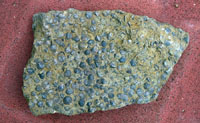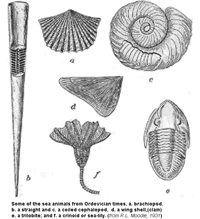2.10: Ordovician Period (485-444 million years)
- Page ID
- 9778
Ordovician Period (485-444 million years)
Shallow seas once again flooded across much of North America through much of the Ordovician Period. Deposition of sediments during this marine transgression resulted in the Tippecanoe Sequence which rests unconformably on top of the Sauk Sequence (see Figure 2.13). However, when sea level rose again (millions of years later) and shallow seas returned to cover large portions of the continents, communities of life forms in the oceans had significantly changed.
Trilobites no longer dominated the fossil record, but other life forms began to proliferate in warm, shallow marine environments. Communities similar to some modern reef-like settings appear in the fossil record. Corals (unrelated to modern varieties), crinoids, cephalopods, brachiopods, bryozoans and other fossil life forms with calcareous skeletons dominate the fossil record. Their abundance reflects their ability to live, proliferate, and upon death, survived burial and fossilization processes). Rare early examples of jaw-less, armored fish and land plants have been discovered in sediment deposits of Ordovician age. Sedimentary rocks of Ordovician age crop out in many locations around the country, but they are perhaps best known from the Cincinnati Arch region (of Ohio, Kentucky and Indiana) where a great abundance of well preserved fossils occur in strata preserved from that time period (Figures 2-26 to 2-28).





